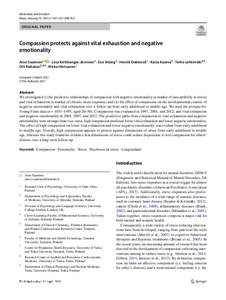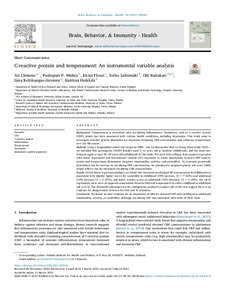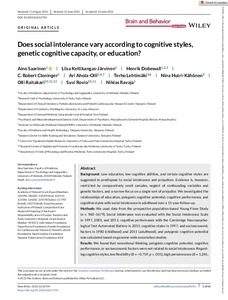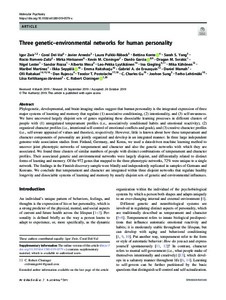Hae
Aineistot 1-8 / 8
Compassion protects against vital exhaustion and negative emotionality
We investigated (i) the predictive relationships of compassion with negative emotionality (a marker of susceptibility to stress) and vital exhaustion (a marker of chronic stress response) and (ii) the effect of compassion ...
DNA methylation signatures of aggression and closely related constructs: A meta-analysis of epigenome-wide studies across the lifespan
<p>DNA methylation profiles of aggressive behavior may capture lifetime cumulative effects of genetic, stochastic, and environmental influences associated with aggression. Here, we report the first large meta-analysis of epigenome-wide association studies (EWAS) of aggressive behavior (N = 15,324 participants). In peripheral blood samples of 14,434 participants from 18 cohorts with mean ages ranging from 7 to 68 years, 13 methylation sites were significantly associated with aggression (alpha = 1.2 × 10<sup>-7</sup>; Bonferroni correction). In cord blood samples of 2425 children from five cohorts with aggression assessed at mean ages ranging from 4 to 7 years, 83% of these sites showed the same direction of association with childhood aggression (r = 0.74, p = 0.006) but no epigenome-wide significant sites were found. Top-sites (48 at a false discovery rate of 5% in the peripheral blood meta-analysis or in a combined meta-analysis of peripheral blood and cord blood) have been associated with chemical exposures, smoking, cognition, metabolic traits, and genetic variation (mQTLs). Three genes whose expression levels were associated with top-sites were previously linked to schizophrenia and general risk tolerance. At six CpGs, DNA methylation variation in blood mirrors variation in the brain. On average 44% (range = 3-82%) of the aggression-methylation association was explained by current and former smoking and BMI. These findings point at loci that are sensitive to chemical exposures with potential implications for neuronal functions. We hope these results to be a starting point for studies leading to applications as peripheral biomarkers and to reveal causal relationships with aggression and related traits.</p>...
Evolution of genetic networks for human creativity
The genetic basis for the emergence of creativity in modern humans remains a mystery despite sequencing the genomes of chimpanzees and Neanderthals, our closest hominid relatives. Data-driven methods allowed us to uncover ...
Magical thinking in individuals with high polygenic risk for schizophrenia but no non-affective psychoses-a general population study
A strong genetic background for psychoses is well-established. Most individuals with a high genetic risk for schizophrenia, however, do not develop the disorder. We investigated whether individuals, who have a high genetic ...
Uncovering the complex genetics of human temperament
<p>Experimental studies of learning suggest that human temperament may
depend on the molecular mechanisms for associative conditioning, which
are highly conserved in animals. The main genetic pathways for
associative ...
C-reactive protein and temperament: An instrumental variable analysis
<div><p><strong>Background: </strong> Temperament is associated with circulating inflammatory biomarkers, such as C-reactive protein (CRP), which has been associated with various health conditions, including depression. ...
Does social intolerance vary according to cognitive styles, genetic cognitive capacity, or education?
<p>Background<br>Low education, low cognitive abilities, and certain cognitive styles are suggested to predispose to social intolerance and prejudices. Evidence is, however, restricted by comparatively small samples, neglect ...
Three genetic-environmental networks for human personality
Phylogenetic, developmental, and brain-imaging studies suggest that human personality is the integrated expression of three major systems of learning and memory that regulate (1) associative conditioning, (2) intentionality, ...







